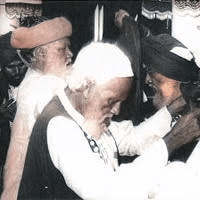The Hijrat Movement was a by-product of the Khilafat Movement. In the summer of 1920 suggestions were made by the local bodies representing the Central Khilafat organization that the Muslims should migrate to place where their religion and national image are not jeopardized. However, the idea gained popularity when Maulana Abul Kalam Azad and Maulana Abdul Bari issued a fatwa declaring India as “Dar-ul-Harab” (Home of War). They urged the Muslims migrate to Afghanistan in religious protest against the British policy. The idea was approved by majority of Muslim scholars including Maulana Ashraf Ali Thanvi, Maulana Habib-ur-Rahman, Maulana Abdul Rauf Danapuri, Pir Mehr Ali Shah and Hakeem Ajmal Khan.
Immediately after the fatwa was issued, a central office of the movement, Khuddam-ul-Muhajreen, was set up in Delhi and Nazims were appointed in all the big cities to motivate people for migration. The movement first gained popularity in Sind. A group of 750 Muhajreen set out for Kabul in a train from Sindh with Barrister Jan Mohammad Junejo as its leader. The train was given great reception by the Muslims on the railway stations where it stopped. This enhanced the vigor for migration amongst the Muslims of the Punjab. Popularity of the movement can be determined from the fact that more than thirty thousand Muslims had left for Kabul by the second week of August 1920.
The movement also spread to the North West Frontier Province. Rather it would not be wrong to say that the rural areas of Peshawar and Mardan were the worst effected areas. The people of North West Frontier Province wrote and sang songs expressing their emotions about leaving India. They sold their land and property to the local Hindu community on the throwaway prices and started moving towards Kabul.
Those who were migrating to Kabul were under the impression that the Government of Afghanistan was ready to receive them. However, the matter of the fact was that in the beginning the Afghan Government welcomed the Indian Muslims but later on when they found that the flood of refugees would be too difficult for them to handle, they closed down their frontiers and refused to accept further migrants. Even those who managed to enter Afghanistan soon came across so many hardships and miserable conditions in the country that they were forced to take a journey back home. The retreat resulted in a heavy loss of life due to the bad weather and disease.
The Khilafat movement failed and the Muslims were left in the lurch. Once again the Muslims were at the brink of disaster facing Hindu contempt and criticism. In this gloomy state of affairs, it was the Muslim League under the fearless and reliable leadership of the Quaid-i-Azam that came forward to pull the Muslims out of their nightmare.
This article was last updated on Monday, Jan 01, 2007






